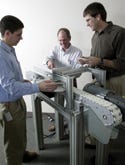GUIDE TO OUTSOURCING
August 1, 2006
|
As competition in the device industry intensifies, OEMs may look to single-source outsourcers to provide multidisciplinary expertise on product development and manufacturing. |
Outsourcing has long been a hot-button issue in all segments of the life sciences industry. In the medical device sector, outsourcing initially took hold in the manufacturing phase, and companies raced across borders and oceans to capitalize on low-cost labor for potentially large profit gains. As the outsourcing model continues to mature, companies are realizing that outsourcing other key areas of product design and development, most notably research and development, can impart large productivity gains that translate into competitive advantages.
In the face of this shift toward outsourcing other phases of medical device development, contract manufacturers could no longer fulfill all of the outsourcing needs of their customers. Medical device companies, in turn, expanded their universe of external partners. But problems arise when too many outsourced firms are involved. Relying on a number of different suppliers to get a medical device to market can be inefficient and time-consuming. In response, medical device manufacturers have begun seeking partners that can provide full-service outsourcing, completing all phases of device development from market research through prototype build and equipment design.
Several trends are driving the need for single-source partners. Among these trends are rapid market growth and the emergence of new industry-spanning market segments. New markets, such as those for combination products and advanced drug delivery, are more complex than traditional markets.
The State of the Medical Device Industry
The medical device industry is a $75 billion market. It is characterized by high profit potential and, therefore, intense competition. With the aging population and the growing demand for home care and self-administered medical treatments, the medical device industry is poised for continued growth, currently estimated to be 8–10% per year.1 To gain a competitive edge in this lucrative market, medical device companies must adapt to continually evolving challenges and differentiate themselves with breakthrough products that beat competing devices to market.
Yet, as competition intensifies, medical device companies must not only work faster and smarter to succeed, but they must also do so with fewer resources. Globalization, coupled with mergers and acquisitions, and new market entrants are intensifying cost pressures, and firms must streamline operations to stay competitive. This continues to spark the contract manufacturing flame, because inexpensive foreign labor is one pathway to win the cost war for some products.
However, producing low-cost products is usually not the most lucrative strategy, especially in an industry where thinking outside the box is not a luxury, but a necessity. Stifling innovation for efficiency's sake will quickly lead a company down the me-too product path, with reduced market share and profitability.
To truly affect the bottom line and increase revenues, companies must devote resources to creating breakthrough products. These revolutionary products are often the result of innovative thinking and multidisciplinary expertise. However, as technologies advance and medical care becomes more complex, companies also need highly specialized know-how to create devices to treat puzzling health problems and to improve quality of care.
|
Allowing one outsourcer to manage an OEM's entire supply chain can reduce the amount of resources that need to be dedicated to a project. |
This need is evident in two of the most promising sectors of the medical device industry: the U.S. advanced drug-delivery market, which is projected to grow more than 18% and exceed $76 billion by 2014, and the combination products market.2 Combination products are classified as two or more regulated components—drugs, medical devices, or biologics—combined through physical or chemical means. Already valued at $5.4 billion in 2004, the global market for combination products is projected to grow 10% per year through 2009.3 These growing segments require specialized skills, such as pharmaceutical formulation, as well as knowledge of polymer engineering, fluid control, etc.
Maintaining such an extensive array of relevant knowledge is simply not feasible for most companies, making the case for outsourced research and development. Similar arguments can be made in favor of working with market research companies to uncover the next urgent medical need in order to direct R&D efforts.
As outsourcing has grown in popularity, it has become common for a medical device company to deal with a marketing consulting firm, a design engineering company, and a contract manufacturer for one project.
The core objective of any outsourcing initiative is to capitalize on the specific strengths of external firms for economies of scale and productivity. This works well until too many players get involved, and the law of diminishing returns sets in. Simply stated, as the number of outsourced partners increases, the resulting rise in productivity begins to wane, and the inefficiencies of overoutsourcing quickly become apparent.
Firms recognize that outsourcing can be used to gain a competitive edge in an aggressive market. Now, however, firms often seek a single partner with a full range of expertise to provide end-to-end project support.
The Move toward Full-Service Outsourcing
With full-service outsourcing, medical device companies can more easily control the device development process and thus enhance productivity. The absence of extraneous parties reduces miscommunication, eliminates transition hiccups, and speeds the project from design through manufacture.
Coordinating the activities of multiple firms can be cumbersome and time-consuming. Working with a single outsourced partner also removes much of the project management burden from the medical device company. This is because using one partner to manage the entire supply chain, from materials suppliers to manufacturers, reduces the amount of resources that need to be dedicated to running the product development process. It also elevates the relationship from simply a vendor-supplier contract to a partnership.
Greater protection of intellectual property also ensues, which is highly beneficial in an industry where innovative breakthroughs are keys to success. The best-kept secrets are just that—secrets. The more parties that become involved in the development of a proprietary, potentially market-revolutionizing product, the greater the chance for information to leak.
One important caveat to be aware of with full-service or single-source outsourcing is that the level of expertise of the partner is more critical than it is in a typical outsourcing relationship. It is imperative that the selected partner possesses knowledge that spans the vertical and horizontal horizons of product development. In particular, the outsourcer must understand the nuances of the specialty area of the medical device company it is serving. If not, innovation will be sacrificed for the efficiency benefits of a one-stop shop.
Not only must the outsourced partner possess technologies and skills from a multitude of industries, but it must also have expertise that spans the entire product development cycle, from market research through manufacturing. A partnership with a multifaceted firm will bear more fruit. A partner that is up to date on the latest technologies is more likely to produce a proprietary product that cannot be copied.
Pitfalls of a Piecemeal Approach
As the old adage says, “Too many cooks spoil the broth,” and many medical device projects have been plagued by delays and inflated costs due to inefficiencies caused by poor project flow.
Given the brief window of time that determines whether a product is revolutionary or a me-too copycat version of the blockbuster, medical device companies cannot afford to waste time. Yet one of the most common problems encountered by firms that overextend their outsourcing relationships is a delayed product launch. Symptoms include insufficient coordination, miscommunication, and missed deadlines.
It is helpful to look at this problem through an example. Let's say that a medical device developer wants to market a disposable device controlled by an electromechanical console. This company uses a design engineering firm for concept development, an offshore IT engineering firm for software development, and a contract manufacturer. Communication between all parties is cumbersome due to cultural and language barriers as well as time differences. Additionally, the software firm's lack of medical industry expertise further derails the project and leads to wasted time and numerous errors.
The piecemeal product development strategy also commonly falls prey to the Band-Aid approach in which continual adjustments are required after the initial design has been finalized. This stems from involving individual partners that do not consider the requirements of the whole project. Working with a single partner that understands the entire device development process, including manufacturing issues, can overcome this hurdle.
An outsourced partner that designs without considering the needs of manufacturing not only raises costs of the medical device company's project, but also detracts from the product's quality. Again using the example above, let's say the contracted design team is tasked with creating a design concept for a console used in clinical environments for direct patient care. The firm finalizes the prototype and passes it to the manufacturing team.
By this time, significant funds and time are likely dedicated to the set design. The manufacturing team recognizes that the concept as designed possesses numerous flaws and ergonomic issues and would require costly assembly in the field. Revamping the design concept in the manufacturing stage would also prove costly. Had the design firm and manufacturing team been from the same company, design flaws could have been uncovered early in the design process, avoiding costly rework and continual product evolution.
Perhaps the external design firm does not consider what would be feasible in terms of manufacturing throughput. To produce the product in the volumes desired, the contract manufacturer would need to employ more workers on the manufacturing line than physically possible. This, too, could be avoided by using a cohesive product development team.
Regulatory compliance can also be at risk if too many parties are involved in a device development project. Myopic vision can prevent identification of a possible safety hazard or can result in a flawed clinical study to the tune of millions of dollars. Working with a firm that understands all of the regulatory implications can help steer medical device manufacturers down a compliant pathway. Regulatory guidance is especially important for developers of combination products. These manufacturers face a more-complicated regulatory process because of the novelty of their products and the additional layers of review.
Conclusion
Although opportunities abound in the medical device industry, only a relatively small number of companies will succeed in bringing blockbuster devices to market. Success requires the right mix of market demand, practical product innovation, engineering expertise, and project management skills.
Although full-service, single-source outsourcing is not a replacement for a manufacturer's creativity or industry experience, it can round out these skill sets. Emerging product segments such as combination products, which could require medical, pharmaceutical, and biotech expertise, amplify the need for multidisciplinary outsourcing. As the complexity of a product or project increases, manufacturers can more easily control the product development process by bringing outsourcing under one roof.
Robert R. Andrews is medical division manager for the commercial group at Foster-Miller Inc., a QinetiQ company based in Waltham, MA. He can be reached at 781/684-4639 or [email protected].
References
1. Ron Sparks, “Forecast for the Medical Device Outsourcing Market: Growth and Consolidation” (New York: Frost & Sullivan, 2006).
2. Kalorama Information and Market Research, “U.S. Market for Delivery-Modified Therapeutics Set to Exceed $76 Billion by 2014,” January 19, 2006.
3. Front Line Strategic Management Reports, “Combination Products: An Impact Analysis on the Convergence of Medical Devices and Therapeutics,” 2003.
Copyright ©2006 Medical Device & Diagnostic Industry
About the Author(s)
You May Also Like




